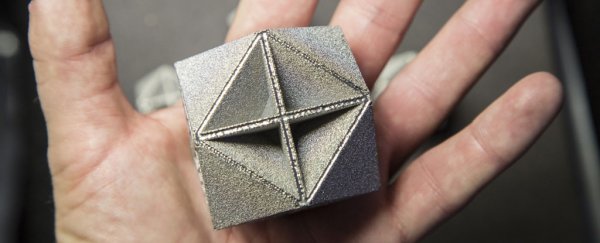Scientists have demonstrated that the design of their new 3D metamaterial is the first structure of its kind to achieve the theoretical limit of stiffness.
Called Isomax, the material is a hard foam based on a repeating formation of geometrically shaped cells. Structures like this are an example of what's called a heterogeneous material – made up of different components – and despite Isomax mostly being air and empty space, it's actually the toughest such composite ever designed.
"The Isomax geometry is maximally stiff in all directions," explains materials scientist Jonathan Berger from UC Santa Barbara.
Berger originally conceived of the design for Isomax in 2015, when he was searching for a material with the highest possible stiffness to lightness ratio.
The idea was to find a repeating cellular 3D structure – such as honeycomb – but one that offered extremely low density in terms of overall mass, and with the maximum possible toughness and crush-resistance.
Now, in a new paper, Berger and his team have backed up their initial computer modelling with new calculations showing that Isomax's geometric structure reaches the limits of elastic stiffness as formulated by a theorem called the Hashin-Shtrikman bounds.
"There was obviously a lot of positive feedback [in 2015]," says Berger, "but for me as a scientist, it's a bit too much hand waving until you have something in a peer-reviewed journal."
Isomax hasn't yet been manufactured, but what makes the material so stiff theoretically is its combination of two basic shapes – a triangle and a cross. Using these two motifs, the Isomax repeating cell is made up of a number of pyramids reinforced by interior walls.
According to the researchers, the intersecting walls are perfect for resisting perpendicular crushing forces, while the pyramidal shapes provide stability and resist shearing (unaligned) forces from opposing directions.
 UCSB Engineering
UCSB Engineering
Because the design of the cell means that Isomax is mostly empty space, the foam ends up being incredibly light, despite its extreme resilience, leading Berger to describe it as "the most efficient [foam] in the Universe".
"Because it has certain symmetries and alignments and achieves the theoretical bounds for stiffness, there is no other material like it," he explained in 2015.
The next step for the team is to investigate the potential of this metamaterial in the real world.
An experimental analysis will let them test the physical resilience of Isomax in the lab, and they're also looking into manufacturing processes that would enable the structure to be fabricated efficiently.
Once manufactured, the team envisages Isomax being used in everything from new kinds of packaging materials to lightweight prosthetic devices.
"It will also be an excellent thermal insulating and sound absorbing material," says one of the team, Haydn N. G. Wadley from the University of Virginia.
"Potential applications for this ultralight material are likely to emerge in aerospace structures, for lightweighting automobiles and in many robotic machines, especially mobile types that carry their own power and must manoeuvre."
The findings are reported in Nature.
